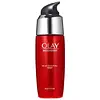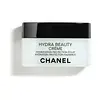What's inside
What's inside
 Key Ingredients
Key Ingredients

 Benefits
Benefits

 Concerns
Concerns

 Ingredients Side-by-side
Ingredients Side-by-side

Water
Skin ConditioningCyclopentasiloxane
EmollientGlycerin
HumectantNiacinamide
SmoothingAluminum Starch Octenylsuccinate
AbsorbentDimethicone
EmollientDimethicone Crosspolymer
Emulsion StabilisingPolyethylene
AbrasivePanthenol
Skin ConditioningTocopheryl Acetate
AntioxidantPalmitoyl Pentapeptide-4
Skin ConditioningSodium PEG-7 Olive Oil Carboxylate
EmulsifyingCeratonia Siliqua Fruit Extract
MaskingPolyacrylamide
Titanium Dioxide
Cosmetic ColorantC13-14 Isoparaffin
EmollientCaprylyl Glycol
EmollientCeramide AP
Skin Conditioning1,2-Hexanediol
Skin ConditioningPhenoxyethanol
PreservativeLaureth-4
EmulsifyingLaureth-7
EmulsifyingDimethiconol
EmollientParfum
MaskingBHT
AntioxidantDisodium EDTA
Citric Acid
BufferingMica
Cosmetic ColorantWater, Cyclopentasiloxane, Glycerin, Niacinamide, Aluminum Starch Octenylsuccinate, Dimethicone, Dimethicone Crosspolymer, Polyethylene, Panthenol, Tocopheryl Acetate, Palmitoyl Pentapeptide-4, Sodium PEG-7 Olive Oil Carboxylate, Ceratonia Siliqua Fruit Extract, Polyacrylamide, Titanium Dioxide, C13-14 Isoparaffin, Caprylyl Glycol, Ceramide AP, 1,2-Hexanediol, Phenoxyethanol, Laureth-4, Laureth-7, Dimethiconol, Parfum, BHT, Disodium EDTA, Citric Acid, Mica
Water
Skin ConditioningGlycerin
HumectantOctyldodecyl Neopentanoate
EmollientHydrogenated Polyisobutene
EmollientSilica
AbrasiveC12-15 Alkyl Benzoate
AntimicrobialPentylene Glycol
Skin ConditioningOctyldodecanol
EmollientPEG-40 Stearate
EmulsifyingCamellia Kissi Seed Oil
EmollientGlyceryl Stearate
EmollientAmmonium Acryloyldimethyltaurate/Vp Copolymer
Zingiber Officinale Root Extract
MaskingCamellia Japonica Flower Extract
EmollientButyrospermum Parkii Butter
Skin ConditioningPhytosteryl Canola Glycerides
Skin ConditioningPhenoxyethanol
PreservativeSaccharide Isomerate
HumectantCetyl Alcohol
EmollientSteareth-2
EmulsifyingDimethicone
EmollientParfum
MaskingCaprylyl Glycol
EmollientSodium Carbomer
Emulsion StabilisingLauroyl Lysine
Skin ConditioningPropylene Glycol
HumectantPEG-12
HumectantPentaerythrityl Tetra-Di-T-Butyl Hydroxyhydrocinnamate
AntioxidantSodium Hyaluronate
HumectantSodium Citrate
BufferingPhytic Acid
Citric Acid
BufferingTocopherol
AntioxidantAscorbyl Palmitate
AntioxidantSodium Benzoate
MaskingWater, Glycerin, Octyldodecyl Neopentanoate, Hydrogenated Polyisobutene, Silica, C12-15 Alkyl Benzoate, Pentylene Glycol, Octyldodecanol, PEG-40 Stearate, Camellia Kissi Seed Oil, Glyceryl Stearate, Ammonium Acryloyldimethyltaurate/Vp Copolymer, Zingiber Officinale Root Extract, Camellia Japonica Flower Extract, Butyrospermum Parkii Butter, Phytosteryl Canola Glycerides, Phenoxyethanol, Saccharide Isomerate, Cetyl Alcohol, Steareth-2, Dimethicone, Parfum, Caprylyl Glycol, Sodium Carbomer, Lauroyl Lysine, Propylene Glycol, PEG-12, Pentaerythrityl Tetra-Di-T-Butyl Hydroxyhydrocinnamate, Sodium Hyaluronate, Sodium Citrate, Phytic Acid, Citric Acid, Tocopherol, Ascorbyl Palmitate, Sodium Benzoate
 Reviews
Reviews

Ingredients Explained
These ingredients are found in both products.
Ingredients higher up in an ingredient list are typically present in a larger amount.
Caprylyl Glycol is a humectant and emollient, meaning it attracts and preserves moisture.
It is a common ingredient in many products, especially those designed to hydrate skin. The primary benefits are retaining moisture, skin softening, and promoting a healthy skin barrier.
Though Caprylyl Glycol is an alcohol derived from fatty acids, it is not the kind that can dry out skin.
This ingredient is also used as a preservative to extend the life of products. It has slight antimicrobial properties.
Learn more about Caprylyl GlycolCitric Acid is an alpha hydroxy acid (AHA) naturally found in citrus fruits like oranges, lemons, and limes.
Like other AHAs, citric acid can exfoliate skin by breaking down the bonds that hold dead skin cells together. This helps reveal smoother and brighter skin underneath.
However, this exfoliating effect only happens at high concentrations (20%) which can be hard to find in cosmetic products.
Due to this, citric acid is usually included in small amounts as a pH adjuster. This helps keep products slightly more acidic and compatible with skin's natural pH.
In skincare formulas, citric acid can:
While it can provide some skin benefits, research shows lactic acid and glycolic acid are generally more effective and less irritating exfoliants.
Most citric acid used in skincare today is made by fermenting sugars (usually from molasses). This synthetic version is identical to the natural citrus form but easier to stabilize and use in formulations.
Read more about some other popular AHA's here:
Learn more about Citric AcidDimethicone is a type of synthetic silicone created from natural materials such as quartz.
What it does:
Dimethicone comes in different viscosities:
Depending on the viscosity, dimethicone has different properties.
Ingredients lists don't always show which type is used, so we recommend reaching out to the brand if you have questions about the viscosity.
This ingredient is unlikely to cause irritation because it does not get absorbed into skin. However, people with silicone allergies should be careful about using this ingredient.
Note: Dimethicone may contribute to pilling. This is because it is not oil or water soluble, so pilling may occur when layered with products. When mixed with heavy oils in a formula, the outcome is also quite greasy.
Learn more about DimethiconeGlycerin is already naturally found in your skin. It helps moisturize and protect your skin.
A study from 2016 found glycerin to be more effective as a humectant than AHAs and hyaluronic acid.
As a humectant, it helps the skin stay hydrated by pulling moisture to your skin. The low molecular weight of glycerin allows it to pull moisture into the deeper layers of your skin.
Hydrated skin improves your skin barrier; Your skin barrier helps protect against irritants and bacteria.
Glycerin has also been found to have antimicrobial and antiviral properties. Due to these properties, glycerin is often used in wound and burn treatments.
In cosmetics, glycerin is usually derived from plants such as soybean or palm. However, it can also be sourced from animals, such as tallow or animal fat.
This ingredient is organic, colorless, odorless, and non-toxic.
Glycerin is the name for this ingredient in American English. British English uses Glycerol/Glycerine.
Learn more about GlycerinParfum is a catch-all term for an ingredient or more that is used to give a scent to products.
Also called "fragrance", this ingredient can be a blend of hundreds of chemicals or plant oils. This means every product with "fragrance" or "parfum" in the ingredients list is a different mixture.
For instance, Habanolide is a proprietary trade name for a specific aroma chemical. When used as a fragrance ingredient in cosmetics, most aroma chemicals fall under the broad labeling category of “FRAGRANCE” or “PARFUM” according to EU and US regulations.
The term 'parfum' or 'fragrance' is not regulated in many countries. In many cases, it is up to the brand to define this term.
For instance, many brands choose to label themselves as "fragrance-free" because they are not using synthetic fragrances. However, their products may still contain ingredients such as essential oils that are considered a fragrance by INCI standards.
One example is Calendula flower extract. Calendula is an essential oil that still imparts a scent or 'fragrance'.
Depending on the blend, the ingredients in the mixture can cause allergies and sensitivities on the skin. Some ingredients that are known EU allergens include linalool and citronellol.
Parfum can also be used to mask or cover an unpleasant scent.
The bottom line is: not all fragrances/parfum/ingredients are created equally. If you are worried about fragrances, we recommend taking a closer look at an ingredient. And of course, we always recommend speaking with a professional.
Learn more about ParfumPhenoxyethanol is a preservative that has germicide, antimicrobial, and aromatic properties. Studies show that phenoxyethanol can prevent microbial growth. By itself, it has a scent that is similar to that of a rose.
It's often used in formulations along with Caprylyl Glycol to preserve the shelf life of products.
Water. It's the most common cosmetic ingredient of all. You'll usually see it at the top of ingredient lists, meaning that it makes up the largest part of the product.
So why is it so popular? Water most often acts as a solvent - this means that it helps dissolve other ingredients into the formulation.
You'll also recognize water as that liquid we all need to stay alive. If you see this, drink a glass of water. Stay hydrated!
Learn more about Water